Personal Finance
The Affordability of Attending an NFL Game, City by City

Attending an NFL game doesn’t come cheap, as every football fan is probably — and perhaps painfully — aware. With each team playing just 16 games a season but facing salary costs of $100 million or more, franchises aim to get the highest return they can on every seat in their stadium, not to mention on every parking space and food stand purchase.
Just how steep a price you’ll pay for an NFL experience depends greatly on where you’re seeing the game. Ticket prices across the league vary by more than 100%, according to data gathered by Team Marketing Report, a sports research site.
In the league’s least expensive stadiums, EverBank Field, home to the Jacksonville Jaguars, and Nissan Stadium in Nashville, Tenn., where the Tennessee Titans play, three tickets, on average, will cost you around $200. By contrast, the average tab for three tickets to see the Chicago Bears at Soldier Field or the New England Patriots at Gillette Stadium is close to $400.
Yet there are also huge disparities in what people earn in the cities that NFL teams call home. For example, the median household earnings in New Orleans and Tampa, Fla., are less than $50,000, while in Washington, D.C., they top $90,000.
Where does all this leave fans when it comes to affording an NFL game? To find out, we gathered the average cost of three NFL tickets — plus parking, food and beer — in every city and converted the median household income in the area into an hourly wage. Dividing those hourly earnings into the total tab yielded the number of work hours required for a family of three to earn enough to attend a local NFL game.
The average across the league was about a day and a half of work, with median earnings of about $30 an hour and the average tab for tickets and extras of around $350. But the work required rose to two days, or close to it, in the least affordable cities, while fans in a few cities could pay their NFL tab through only a day or so of toil.
Unsurprisingly, the least affordable cities tended to have some of the highest costs, along with incomes that were below the national norm. However, high prices didn’t always coincide with unaffordability; some pricier stadiums serve affluent cities where fans can cover their NFL fix with relative ease. Alternatively, some teams located where incomes are below the norm were quite affordable, too, since their prices were in line with the modest pay of the city they served.
How much does the average household spend on entertainment each month? Find out in our Average Household Budget guide.
Most affordable teams
In these cities, you need to work about a day (albeit a long one) to pay for your family trip to the stadium. That is, covering the tab requires around nine hours, on average, compared with close to 12 hours on average across the league.
Unsurprisingly, the price tabs to see most of these teams are below the norm. In the case of the Tennessee Titans, its $261.45 tab earns you pretty decent football in the main concourse, according to the USA Today NFL Power Rankings.
Unfortunately, the other notably cheap teams in the group offer football quality that’s commensurate with their low prices. The Jacksonville Jaguars and Los Angeles Rams, with costs of $252.08 and $273.88, respectively, have been offering notably poor performances in recent seasons. On the other hand, if you pay a little more ($290.09) to see the Oakland Raiders, or significantly more ($338.60) to see the Seattle Seahawks, you have a better-than-even chance of enjoying high-quality football, since both teams rank high in the USA Today rankings. The Minnesota Vikings ($316.01) are middling in price, and in their ranking.
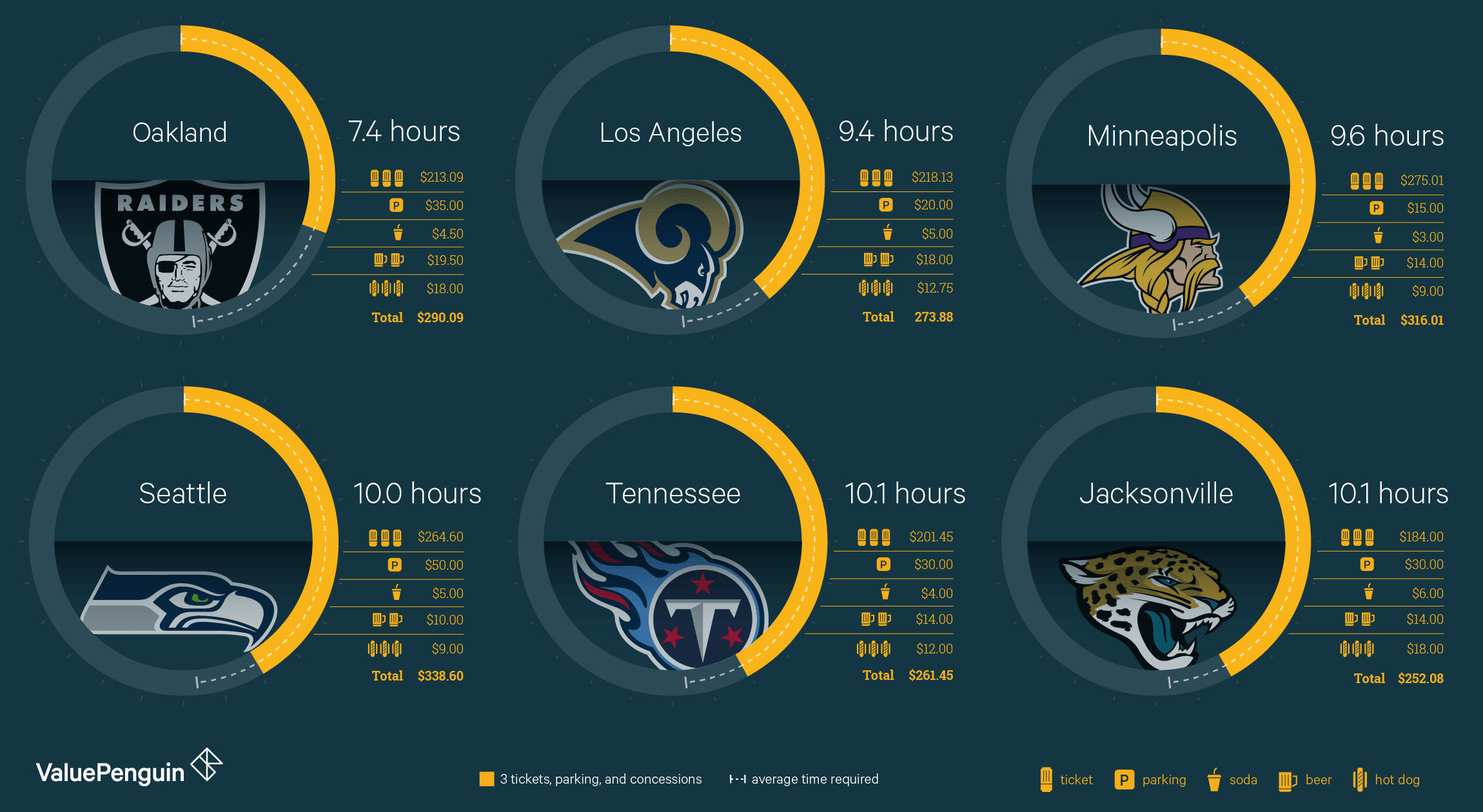
Least affordable teams
Two days, or even close to it, is a lot of work to take your family to an NFL game. But that’s what you need to pony up if you live in one of these places. In the least affordable cities of all, Chicago and Dallas, incomes are only a little below the national median, but costs are among the highest in the league — $483.20 and $444.10, respectively. Among the exorbitant fees in Dallas is a $75 parking charge, which is not only the highest in the NFL, but of any team we’ve tracked in the NBA and MLB, as well.
In each of the other three locations — New Orleans, Green Bay, Wis., and Pittsburgh — the cost drops to around $350, or just a little above the average for the league. Unfortunately, median incomes in those cities are in the $50,000 range, which is well below the national average. The result: you need to work almost as long (upwards of 14 hours) to pay the tab in these places as in more affluent Chicago and Dallas.
(The same applies to the #6 team for unaffordability, the Buffalo Bills, with 13-plus hours of toil required for a trip to New Era Field, despite a tab of $334.54, which is a bit below the average.)
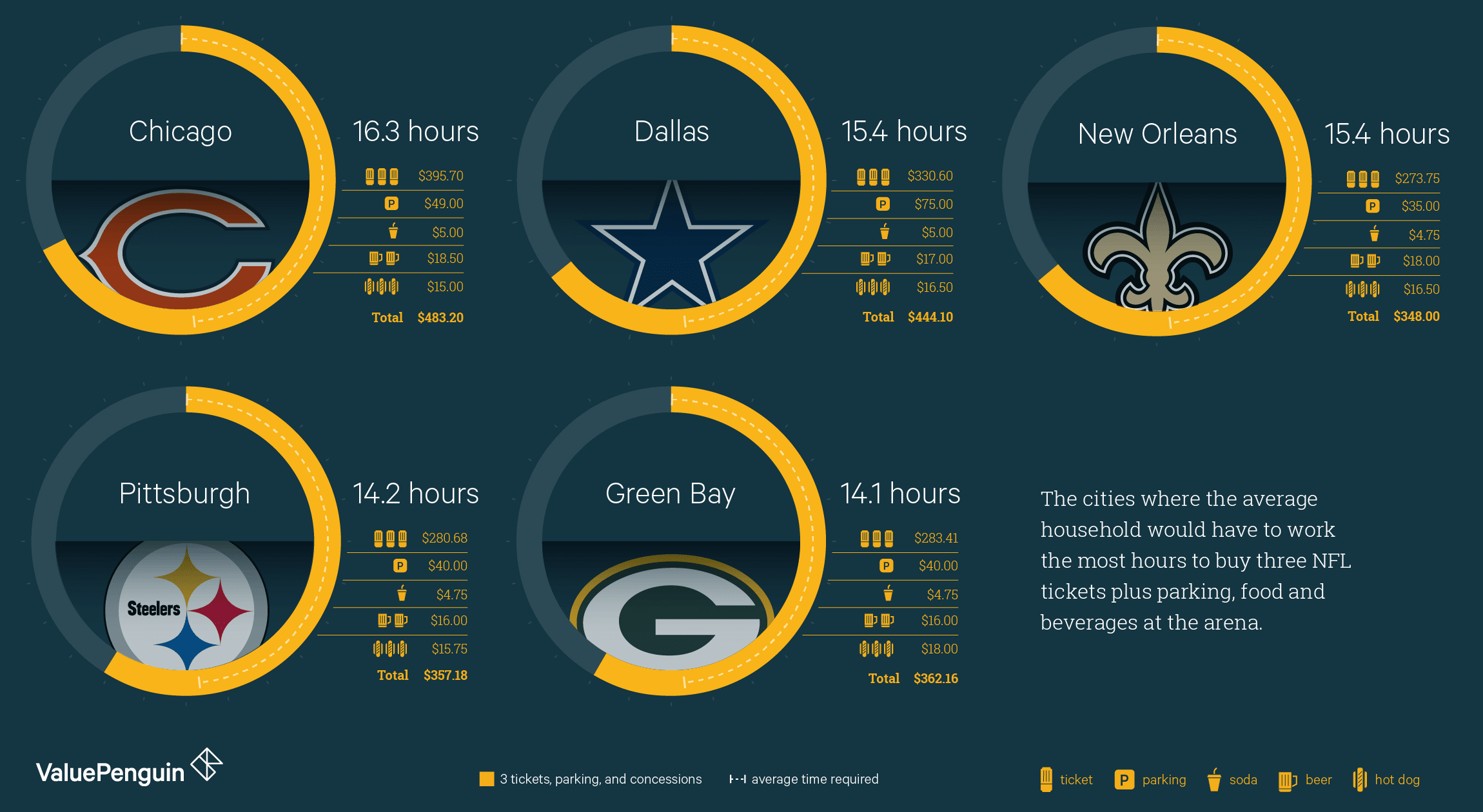
All NFL teams ranked
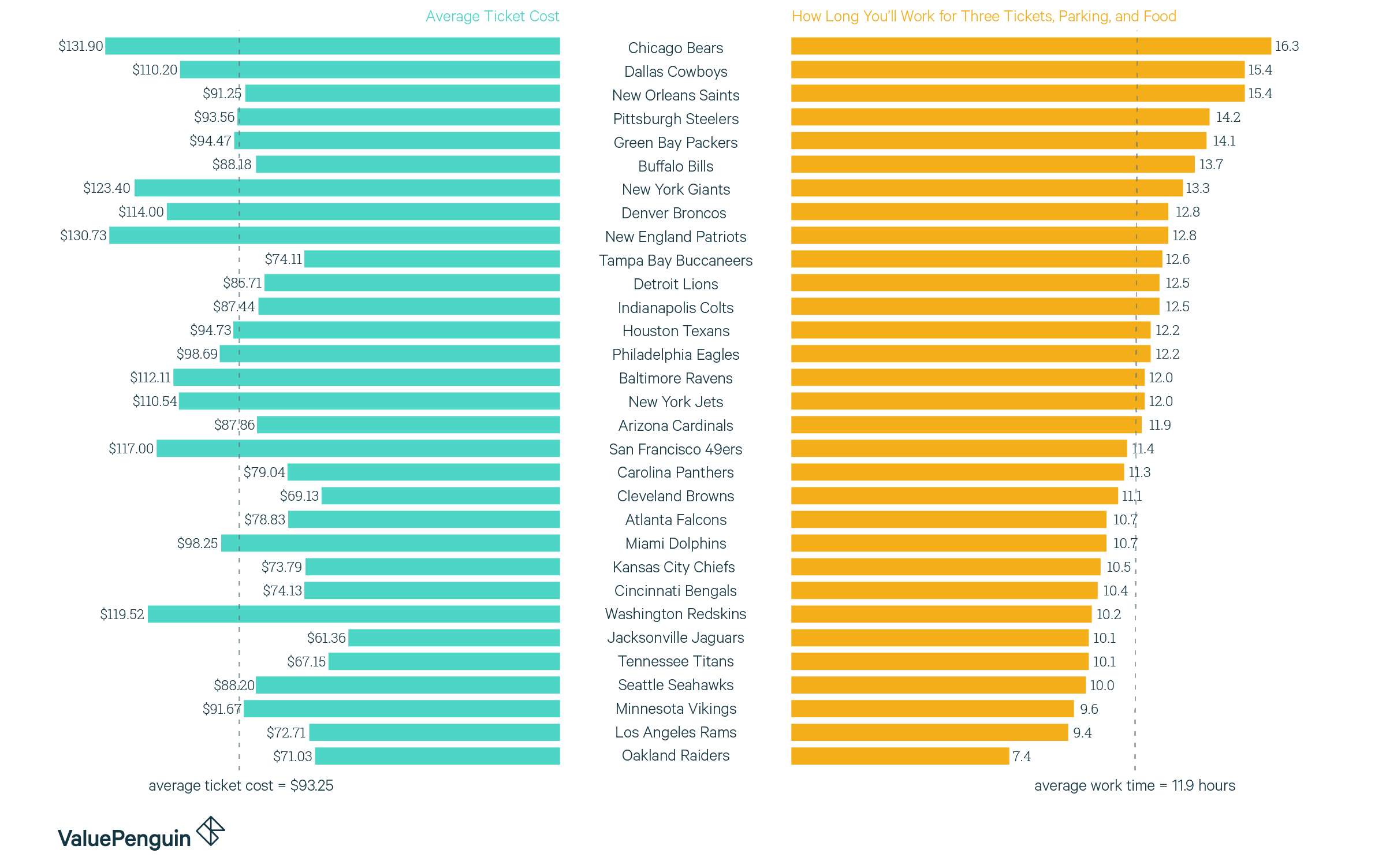
How local rivals stack up
In some metro areas or regions, fans have the choice between two teams that are within easy driving distance. Fan costs, not to mention football quality, can vary widely between regional rivals.
Northern California
Nothing better exemplifies how the cost and quality of the NFL experience don't always align than a comparison of the rival teams in the Bay Area. A trip to see the San Francisco 49ers in Levi's Stadium in Santa Clara, Calif., will set you back an average of $448.50, thanks in part to such fees as $60 for parking. That total cost is more than $150 above the $290.09 tab for taking the family to the Oakland County Coliseum to watch the Oakland Raiders (where, by the way, parking will cost you a mere $35).
Using a single median income for the Bay Area, that gap translates into a full half-day of extra work to pay for the 49ers experience compared with the Raiders. If only the 49ers were the better team. Instead, they've been offering fairly dismal performances, while the Raiders have been residing close to the top of the USA Today NFL Power Rankings.
Looking ahead, however, the Raiders are scheduled to move into a new stadium next season. Based on the history of pricing after other such moves, Oakland fans could soon be paying more across the board, especially if the team can leverage stellar on-field performances to further justify raising its prices.
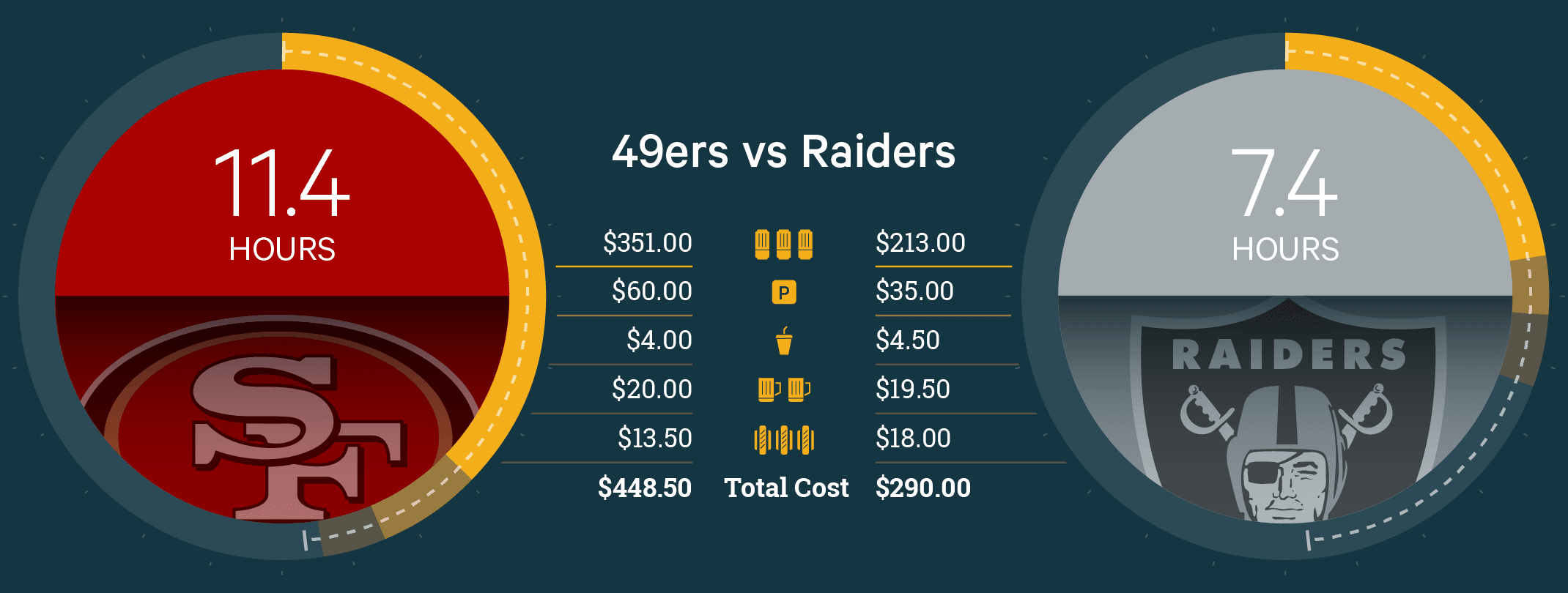
New York
New York's two NFL teams play in the same stadium, which isn't even in New York State, let alone New York City. The cost to see either team at MetLife Stadium in New Jersey is above the national average. But where the New York Jets experience is merely pricey, at $387.62, the tab to see the New York York Giants is positively stratospheric — the fourth most expensive in the league, at $431.20. Still, due to the high median income of the New York City area, fans can cover that cost difference with only a little more than an hour of work. And at least the Giants are offering better, if hardly stellar, football for the extra money they charge. The Giants hover in the middle of the USA Today NFL Power ratings, where the Jets are at or near the bottom.
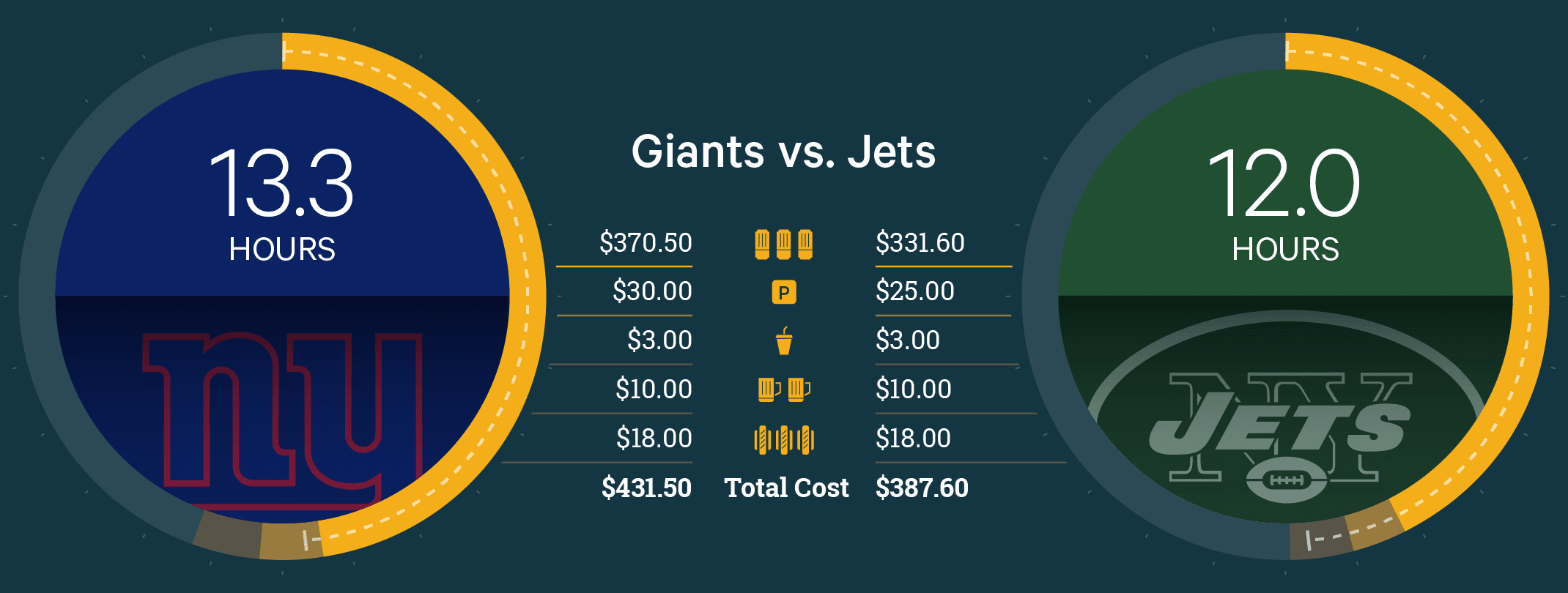
Methodology
Using the U.S. Census Bureau's calculation that the average family comprises 2.58 people, we multiplied the average ticket prices in 2016 (gathered by Team Marketing Report) by three to represent an average family's ticket cost to enjoy a live NFL experience.
To better reflect the total cost of the trip, we further used Team Marketing Report data to add the cost of food (three hot dogs), beverages (two beers and a soda), and parking at the stadium. We then gathered U.S. Census data on each metro area’s median household income, based on U.S. Census Data for 2015, the latest available year. The specific metro areas are listed below.
Using this data, we calculated an hourly income by dividing the annual income by 2080, which reflects the total hours from working 52 full (40-hour) work weeks. That sum was then divided into the total cost of the tickets and other extras (beers, hot dogs, soda, parking). That yielded the number of hours the average household would need to work in order to see their hometown team play.
Because we were forced to use 2016 data, we removed the San Diego Chargers from the list, since the team has moved to a new city (Los Angeles) and a new stadium, complicating the calculation of both costs and income.
Here's a listing of the metropolitan areas from which median household income was gathered from the U.S. Census (with the relevant team):
- Baltimore-Columbia-Towson (Ravens)
- Boston-Cambridge-Newton (Patriots)
- Buffalo-Cheektowaga-Niagara Falls (Bills)
- Charlotte-Concord-Gastonia (Panthers)
- Chicago-Naperville-Elgin (Bears)
- Cincinnati (Bengals)
- Cleveland-Elyria (Browns)
- Dallas-Fort Worth-Arlington (Cowboys)
- Denver-Aurora-Lakewood (Broncos)
- Detroit-Warren-Dearborn (Lions)
- Green Bay (Packers)
- Houston-The Woodlands-Sugar Land (Texans)
- Indianapolis-Carmel-Anderson (Colts)
- Jacksonville (Jaguars)
- Kansas City (Chiefs)
- Los Angeles-Long Beach-Anaheim (Rams)
- Miami-Fort Lauderdale-West Palm Beach (Dolphins)
- Minneapolis-St. Paul-Bloomington (Vikings)
- Nashville-Davidson-Murfreesbro-Franklin (Titans)
- New Orleans-Metairie (Saints)
- New York-Newark-Jersey City (Jets and Giants)
- Philadelphia-Camden-Wilmington (Eagles)
- Phoenix Mesa-Scottsdale (Cardinals)
- Pittsburgh (Steelers)
- San Francisco-Hayward-Oakland (49ers and Raiders)
- Seattle-Tacoma-Bellevue (Seahawks)
- Tampa-St. Petersburg-Clearwater (Buccaneers)
- Washington-Arlington-Alexandria (Redskins)
